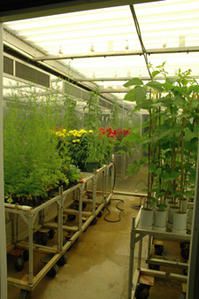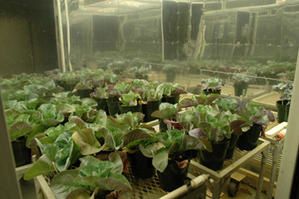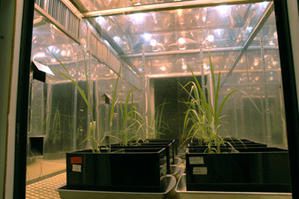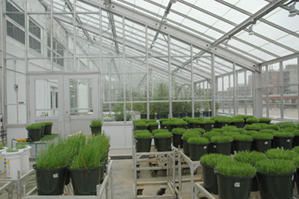The Phytotron of NCSU (USA)
The North Carolina State University Phytotron :
link
The NCSU Phytotron contains 57 growth chambers and 5 greenhouses and space is available for use by off-campus researchers.
 Control of the Environment: As Old as
Agriculture
Control of the Environment: As Old as
Agriculture
When people first began to clear away natural species and plant crops in their place, they were making the first efforts to control the environment. Eliminating weeds, applying manure to improve soil fertility, and adding water through irrigation were additional attempts to exert even greater control over the environment. By 100 A.D. farmers of the Roman Empire were growing vegetables and roses in pits covered with sheets of mica and heated with fermenting manure or hot water. Somewhat later, grapes, oranges, and other fruits were adapted to local climate by planting them against the heat-retaining south wall of masonry houses. Adding fireplace flues to these walls provided additional heat. By the mid 17th century, walls could be made of glass, and plants began to come inside. Hotbeds and greenhouses were used to force the season on delicacies in Virginia and the Carolinas before the Revolution. Orange trees were grown in a Virginia greenhouse in 1737. Further north, Boston had a greenhouse by 1720; New York by 1764. Off-season production of specialty crops in greenhouses developed over the years, along with the research potential of greenhouses. Greenhouses proliferated after the era of hot water heating began in the early 19th century. But even in greenhouses, botanists did not have close control of temperature, humidity, photoperiod, or other environmental factors, and reproducible experiments were difficult to design. The greenhouse atmosphere, for example, was not under control, so that even plants grown from genetically identical seed would not necessarily produce phenotypically uniform results.
Closing the System
Only in the late 1940's when human comfort air
conditioning became fairly common, and the relatively high output slimline fluorescent lamp was developed, did closed plant growth chambers with complete environmental control become possible.
The great advantage of a phytotron lies in the control of many environmental factors simultaneously. The composition of the air, the temperature, the humidity, the daylength, light spectrum, root
zone temperature, and nutrition can all be programmed so that the effects of a change in one factor can be isolated in ways that are not possible in field or greenhouse experiments. The first
phytotron, the Earhart Laboratory, was built by botanist F. W. Went at the California Institute of Technology in 1948. With 54 separate air-conditioned and artificially lighted rooms programmed
for a range of conditions, the facility had great flexibility for setting different combinations of temperature, light, and humidity.
 NCSU Builds Phytotron
NCSU Builds Phytotron
In 1968 another phytotron was constructed in the United States, this one at NCSU.
Formally called the Southeastern Plant Environment Laboratory, the NCSU phytotron is a leading center for controlled environment research in the United States, and one of the largest such
facilities in the world. With 60 artificially lighted growth chambers of various sizes, 9 photoperiod rooms, and 5 temperature-controlled greenhouses, the phytotron lends itself to an enormous
number of experiments - usually between 50 and 70 different projects each year. The range of subjects is broad, including very basic studies of plant physiology as well as practical problems of
crop species. Unlike a number of other phytotrons which maintain all chambers and greenhouses at set environmental conditions, the NCSU Phytotron provides customized environmental programming for
each experiment. Only eight of the large walk-in chambers and the five greenhouses are operated at set conditions on a permanent basis to serve many experimenters simultaneously.
Not Just Plants
Although the controlled-environment facilities were initially designed for plant
research, they are also useful for many kinds of animal and insect studies where control of daylength and temperature is desirable. Zoologists and entomologists have used the NCSU Phytotron facility for the study of lizards, ghost crabs, woodcocks, pine voles, mice, wood roaches, grasshoppers, bean beetles, fruit weevils, spruce bud mites, house dust
mites, gypsy moths, and fish.
 A Global Resource
A Global Resource
The Phytotron is used by scientists from NCSU departments in the Colleges of Agriculture and Life Sciences, Forest Resources, and Physical and Mathematical Sciences, as well as from the U.S. Department of Agriculture, many other U.S. and overseas universities, and some private industries.
With such intensive demand, the centralized facility is used fully and very efficiently. A full-time staff of 10 includes the Director, Dr. Carole Saravtz, and Director Emeritus, Dr. Robert J. Downs, as well as the Phytotron manager, technicians, and mechanical and electronics experts who help investigators with the development of special equipment and instrumentation. Among the environmental factors that can be controlled in the phytotron are:
-
- air temperature rootzone temperature daylength (photoperiod) irradiance and spectral quality of light carbon dioxide concentration relative humidity- nutrient concentration and pH
The Seed Germination LaboratoryTwelve germinators are available which can be set to a range of constant and alternating temperatures. Red and far-red sources of known spectral energy distribution are available for light-requiring seeds. Two large incubators can be equipped with light sources and can provide low temperatures for stratification and vernalization treatments to hasten maturity.
 The Air Pollution
Laboratory
The Air Pollution
Laboratory
Eight customized roomettes have been designed for both acute and chronic exposures to phytotoxic gases under controlled temperature, humidity, and carbon dioxide conditions. Exposure chambers are equipped for control and monitoring of carbon dioxide, ozone, nitrous oxide, sulfur dioxide, and ethylene. Water and nutrient solutions are dispensed automatically in these roomettes to maintain the long-term stability of the internal environment.
Root Zone-Hydroponic - UnitsContinuous flow liquid culture units automatically control pH level and temperatures between 10 ° and 35 ° C
(50 ° and 95 ° F). With individual units available, the effects of different nutrient treatments can be studied simultaneously.
Plant Pathogen Isolation AreaThe effects of plant pathogens can be studied in the four walk-in chambers and laboratory set aside for this purpose. Contamination of other areas of the Phytotron is prevented by keeping air pressure lower than in other sections, and equipping the air exhaust system with spore-trapping filters. Automatic watering and view ports in chamber doors reduce personnel movement and potential contamination in these rooms to the minimum.
Cold ChambersConstant, daily or programmed chilling temperature conditions are possible in two small walk-in chambers. Temperatures can be lowered to 39 ° F (4 ° C) in the light and 32 ° F (0 ° C) in the dark. These rooms are used for studies of environmental physiology, chilling resistance in crops, and chemical means of freeze protection.
High Intensity Light RoomsTo meet increased demands for studies of the effects of high intensity light levels approaching natural sunlight, two reach-in chambers have been fitted with super metal halide lamps which can be used alone or in combination with incandescent lamps and/or high pressure sodium lamps. Intensities of 1000 to 2000 mol m-2 s-1 can be reached in these rooms.

/image%2F0550795%2F201304%2Fob_ae1487_2012-06-03-fukushima-photo-jm-bonzom-010.jpg)


/image%2F0550795%2F20210525%2Fob_0ab922_index.png)
/image%2F0550795%2F20200116%2Fob_568342_bann-systemes-info-027.jpg)
/https%3A%2F%2Fassets.over-blog.com%2Ft%2Fcedistic%2Fcamera.png)
/image%2F0550795%2F20191021%2Fob_2e6196_bandeau.png)
